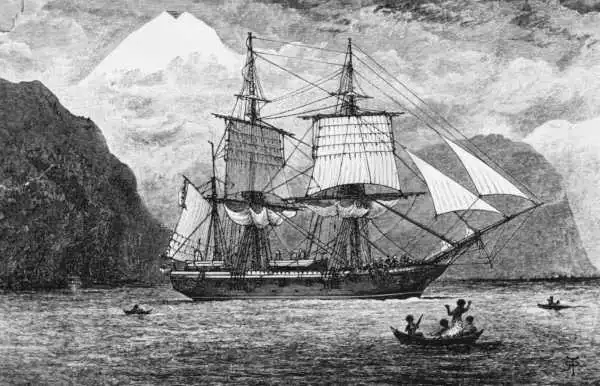Charles Darwin’s association with HMS Beagle

In 1820, 200 years ago this year, one of the most fascinating British naval vessels was launched. This 10-gun, Cherokee class brig-sloop would have likely passed into history without note if it wasn’t for one voyage with a very famous passenger – Charles Darwin. The ship we’re exploring today is the HMS Beagle, famed for being the boat which carried Darwin on his voyage of discovery to the Galapagos Islands and playing a role in his development of the theory of natural selection- what we now know as evolution.
After being build, there was no pressing need for the Beagle, so she lay “in ordinary”- that is without masts or rigging but afloat- until she was repurposed as a survey vessel. Repairs and retro-fitting changed her designation from a brig to a barque and she then set sail on her first surveying journey.
Tasked to the hydrographic office, Beagle was part of a flotilla charged with charting the seas and coasts around Patagonia and Tierra Del Fuego. She was to accompany the much larger HMS Adventure.
The journey had many fascinating, if rather dark, incidents, including the suicide of the captain and the taking of native Fuegians as hostages in retaliation for the theft of a ship’s boat, but this is not the journey which made her famous. However, she did earn the honour of having the Beagle Channel named after her.
It is the second voyage that made Beagle a household name.
The captain, Fitzroy, had served as captain towards the end of Beagle’s first voyage, having been appointed over the acting captain who had taken command after the death of the first captain. He had a reputation as an able commander and fastidious surveyor- placing great pride in the accuracy of his work.
This desire for accuracy and pride in his vessel lead Fitzroy to spend huge amounts of his own money refitting the Beagle for a second time. He had installed 20 chronometers and a sympiesometer (a kind of mercury free barometer) which allowed for a huge degree of accuracy in surveying and charting.
Command in those days could be an intensely lonely and stressful situation. Not only had Beagle’s first captain committed suicide mid voyage, Fitzroy’s own uncle had done the same thing. With this in mind, Fitzroy searched for a civilian expert who could join him on the voyage- not only to loan expertise to the mission, but to serve as company and a friend outside the command structure.
Fitzroy originally wanted a friend who was a geologist, someone who could study the land as he and his men studied the sea, but this fell through. He then sought a “gentleman naturalist” to accompany him. The man who was introduced in this roll was none other than Charles Darwin.
Darwin was brought on board primarily for his knowledge of geology but it was his fascination with living species which would go on to make him famous.
Darwin made this voyage famous in his work Journal and Remarks, which is, since its republication in 1905, more often titled The Voyage of the Beagle. This book contains the first glimmerings of Darwin’s famous theory- he hints that he suspects that species are not “fixed” but instead adapt to their environment.
Darwin credits his time aboard the Beagle as his first real training in the science of natural history, famously noticing the abundance of strikingly similar, yet clearly different varieties of beak on the birds found between islands. In the book he hints at the theories developing from this observation but states “there is not space in this work to enter into this curious subject”.
Darwin would spend 5 years on this voyage, but as a gentleman naturalist, he likely only spent 18 months physically on the ship. It would be fair to say he was not a natural sailor- he suffered terribly from seasickness.
Spending time in various places during the 5 year mission, Darwin was fascinated by the nature he was exposed to but equally disgusted by the injustices he witnessed- particularly the slavery which was so common in South America. He also found himself pulled into a military engagement, joining armed members of the crew in the retaking of a fort held by rebels.
The voyage, containing both the joy of exploration and nature and the suffering of the hardships of travel left an indelible mark on the deeply religious and sensitive Darwin and would shake him to his very core as his intelligent and questioning mind processed all that he saw.
How could nature have been the creation of a benevolent god when things like the ichneumon wasp (which stores caterpillars to be eaten alive by its offspring) existed? While this questioning is what made him the household name we know today and one of the founding fathers of modern science, it deeply troubled him on a profound level.
Towards the end of his time on the Beagle, Darwin devoted himself to finishing his paperwork. His notes totalled 1750 pages, his diary another 770 and he drew up 12 volumes of sample catalogues containing 5436 skins gathered on the voyage. This would supply him with the core material that would eventually lead to the formation of the theory we know him for today.
Many of these samples are now housed in the Natural History Museum, right here in London. Having the chance to see them is the perfect excuse to visit this wonderful collection. If you’d like to join me to learn more about Darwin and his discoveries, or see any of the exhibits, I would love the chance to speak on the subject further during a tour.